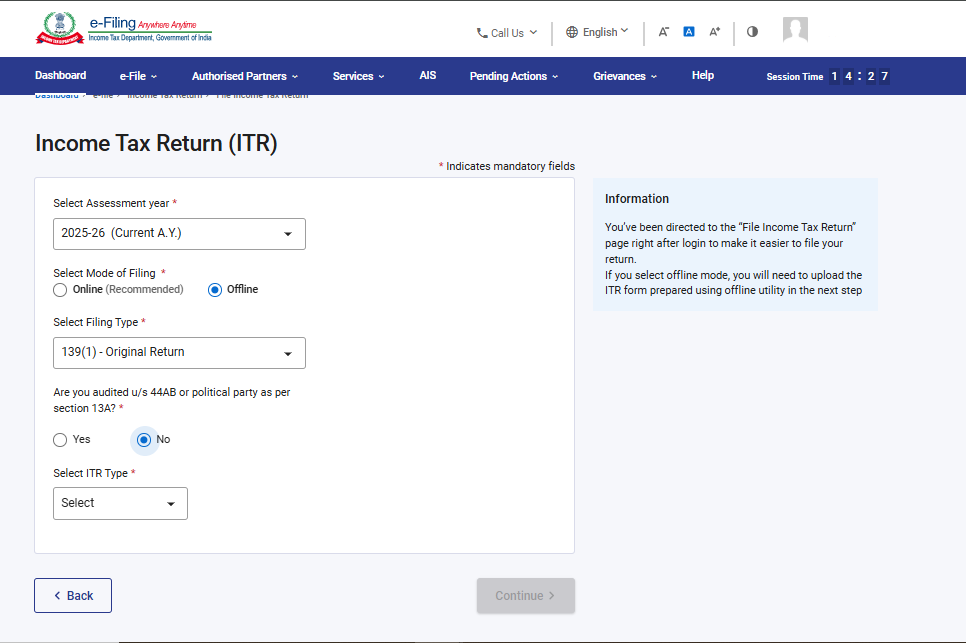
How to Open JSON File in Income Tax Portal
A JSON file in income tax is a structured file format used to upload or download your ITR data on the Income Tax e-filing portal. It contains your return details in a machine-readable format. To open a JSON file, you can use the Income Tax Utility or import it directly on ClearTax for easy filing.
How To Use JSON File?
A JSON file is a widely used data format that stores structured data in a readable format. You can open and edit JSON files using any simple text editor like Notepad or advanced tools like VS Code. JSON files are commonly used to exchange data between a client and a server, configure applications, or store and update data in web-based platforms. For income tax filing, you can download your ITR JSON file from the income tax portal and upload it to supported tax filing software for quick and easy return filing.
How to Download JSON Offline Utility from Income Tax Portal
Take a look at the steps below for downloading JSON offline utility:
Step 1: Visit the official website of the e-Filing Income Tax portal and click on the ‘Downloads’ option on the dashboard. Select Assessment Year 2025-26.
Step 2: Click on the necessary option to download the utility for ITR 1 to ITR 4. (Run and Install the utility)
Step 3: After installation, you can navigate to the ‘Homepage’.
Step 4: Click on the ‘Continue’ option. Once redirected, you can easily file your income tax return for the Assessment Year 2025-26.
How To File ITR Using JSON
Many individuals confront different challenges related to filing ITR using JSON in the income tax portal. If you are one of those individuals, here is a step-by-step guide to file ITR using JSON:
Step 1: First, prepare your ITR with offline Utility and navigate to the official website of the e-Filing Income Tax portal.
Step 2: Log in with your credentials, and On the e-Filing Dashboard, click on the ‘e-File’ option, select ‘Income Tax Return’ from the available options and Click on ‘File Income tax return’.

Step 3: Click on the ‘Continue’ option, select ‘Offline’ mode, and Select Assessment Year 2025-26 and Filing Type.

Step 4: Then, upload the JSON file. (Income Tax Site will validate the JSON File.)

Step 5: On successful validation, and click Proceed to Verification. After that, proceed with ITR filing.
Step 6: Now, you can e-verify your return (it is Mandatory to e-verify your return within 30 days of filing your ITR). E-verification is the easiest way to verify your ITR. It is quick, paperless, and safer than sending a signed physical ITR-V copy to CPC by Speed post.
Step 7: You will receive a confirmation email on your registered email ID with your confirmation number and ITR Acknowledgment.
How To Open JSON File in Excel
There are various versions of MS Excel available that allow users to open JSON files in Excel. To open the JSON file in Excel or import it, you need to follow the following steps:
Step 1: First, open a new or existing Excel file and navigate to the Data tab.
Step 2: Under the new query drop-down option, click ‘From file’ and ‘From text’.
Step 3: Now go to the JSON file on your computer where it is originally located and change the file type.
Step 4: After changing the file type from ‘Text file’ to ‘All files’, click on the JSON file.
Step 5: Hit the ‘Import’ button to import this required file data into an Excel sheet.
Step 6: Now, open the power query editor window available in the Excel sheet under the ‘Get data’ tab.
Step 7: Click on the ‘To table’ option and then select ‘Ok’.
Step 8: A power query editor will reload, and after that, click on the ‘Square box icon’ present next to ‘Columns’. If you want, you can deselect any columns as per your requirement.
Step 9: You can now see all records present in your JSON file. Then, click on the first ‘Close and load’ option.
Step 10: Finally, you will notice that the data sets have been uploaded to the Excel sheet.
Steps To Open JSON File In PDF
Opening a JSON file does not include any complicated procedure. All you need to do is follow these simple steps:
Step 1: Download any PDF converter software.
Step 2: Upload a JSON file to convert.
Step 3: Click on the ‘Convert’ option and download the PDF file within a few seconds.
Final Word
It is quite evident that a JSON file is easy to analyse and perfect for storing temporary data. You can conveniently use this file format to store and exchange data over a web network. Therefore, while filing your income tax returns, you can upload a JSON file containing all necessary information, which will then get transferred to the concerned official.
Frequently Asked Questions



